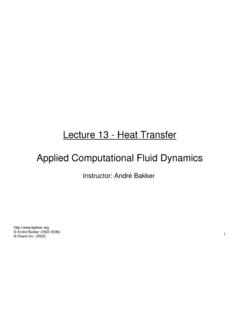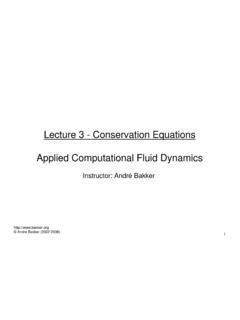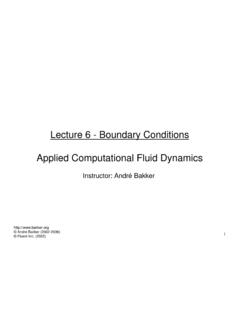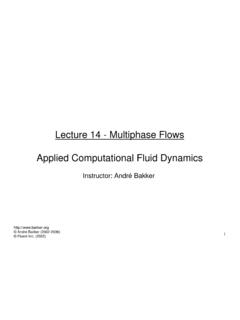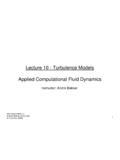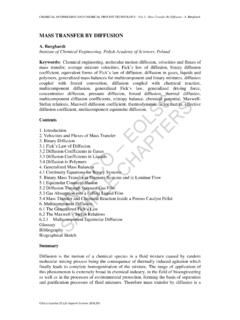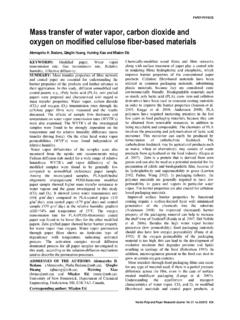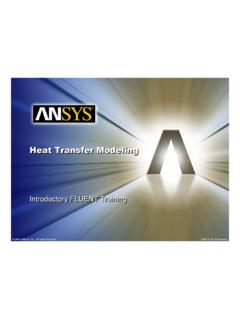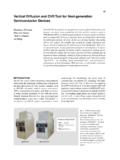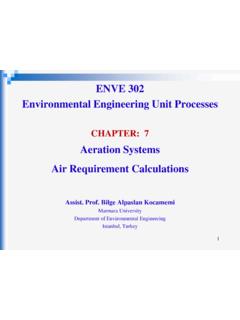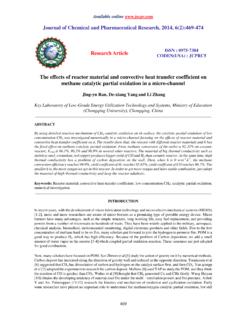Transcription of Modeling Material/Species Transport Reacting Flows - …
1 1 Modeling Material/Species Transport Reacting Flows - Lecture 8 Instructor: Andr Andr Bakker (2006)2 Outline In addition to flow fields, we often need to model additional physics. The fluid velocities Transport a number of properties: mass of one or more materials. Momentum. Energy. Proper Modeling of material Transport is necessary if we want tomodel mixing or reaction. Methods to model material Transport : Discrete phase Modeling (DPM), aka particle tracking. species Transport , aka scalar Transport . Multiphase flow Modeling , Eulerian flow flow multiple momentum eqns. Multiphase flow is simultaneous flow of: Materials with different states or phases ( gas, liquid or solid). Materials in the same state or phase, but that are immiscible ( liquid-liquid systems such as oil droplets in water). Each phase has its own velocity field and its own momentum.
2 It is therefore often necessary to solve multiple sets of momentum equations, one set for each phase. Interaction between the phases requires the introduction of momentum exchange terms. Models are often complex, and time consuming to solve. Will not discuss with single set of momentum eqns. We will discuss material Transport in systems that are adequately described by a single set of momentum eqns: species or scalar Transport . Particle tracking (DPM). One fluid flow field is solved. The rate of Transport of the species or particles is derived from that single fluid flow field. The local concentration of species or particles may affect the flow field Transport The species Transport equation (constant density, incompressibleflow) is given by: The concentration of the chemical species is c. The velocity is ui. Dis the diffusion coefficient.
3 Sis a source term. This equation is solved in discretized form to calculate the Transport and local species ()iiiiccu cStxxx +=+ D6 Convection is Transport of material due to the velocity of the fluid. Flux from one grid cell to the next is area times normal-velocity times concentration. From cell p to E : Values at cell faces required! Implication: for best accuracy, use higher order Transport the convective term()iiiiccu cStxxx +=+ DcPcEcWAe,ce,ue7 Diffusion is Transport resulting from concentration gradients. Diffusion flux from one grid cell to the next is area times the concentration gradient times the diffusion coefficient. From cell p to E : Gradient at interface between cells is easily calculated. The main difficulty is the calculation of the diffusion Transport the diffusive term()iiiiccu cStxxx +=+ DcPcEcWAe,ce,ueeedcAdxD8 The diffusion term - molecular Molecular diffusion: As a result of concentration gradients: mass diffusion.
4 As a result of temperature gradients: thermodiffusion. mass diffusion coefficient: Constant dilute approximation: same constant for all species . Dilute approximation: different constant for each species . Multi-component: a separate binary diffusion coefficient Dijfor each combination of species i into species j . Thermodiffusion: flux is proportional to thermal diffusion coefficient DTand temperature gradients: Not usually important in industrial chemical D9 The diffusion term - turbulence Turbulent diffusion: Transport due to the mixing action of the chaotic turbulent velocity fluctuations. The turbulent diffusion coefficient is calculated from the turbulent viscosity t: The turbulent Schmidt number Sctis a model constant. Recommended values are: if an eddy viscosity turbulence model is used, k- . if the Reynolds stress model (RSM) is =D10 species Transport source terms The source term: This describes all other effects: Creation or destruction of species due to chemical reaction.
5 Any other physical phenomena the user wants to implement.()iiiiccu cStxxx +=+ D11 Model setup Model setup: Specify which species are present in the mixture. Specify properties of all species . If N species are present, N-1 equations are solved. The concentration of the Nth species follows from the fact that all mass fractions Yishould sum to (/) mass fraction:(/)mixture density:iiiimixturemixtureiiYc kg mYkg mc === 12 Boundary conditions Wall boundary conditions: Either specified mass fraction, or zero flux. Inlet boundary conditions: At inlets, the inlet flux is calculated as: Need to specify inlet concentration/ mass fraction. The inlet diffusion flux depends on the concentration gradient. Value can not be predicted beforehand. If a fixed mass flow rate is desired, this term should be disabled. Outlet boundary conditions: specify species mass fraction in case backflow occurs at outlet.
6 Nncu cx D13 species equation is one-way! All species have the same convective velocity. Diffusion usually reduces concentration gradients mixing. As a result, the diffusion equation can not usually be used to model separation! To model separation, multiphase models where the phases have different velocities are necessary. Exceptions: Some laminar flow, thermal diffusion dominated cases. Cases with complex Transport models implemented through source mechanism Laminar mixing. CFD simulation. Six elements. Each element splits, stretches and folds the fluid parcels. Every two elements the fluid is moved quantification species concentration in sample points at different axial locations. Coefficient of variance:( )( )stdev cCoVaverage c=Kenics mixerSix elementsRe=1088 evenly spaced sample points in each axial of sample plane pointsSurfaces | PlaneFile | Write | Profile17 Particle trajectories in a cycloneParticle tracking Solve one set of momentum equations for the fluid flow.
7 In an Eulerian reference frame, on the grid locations. Simulate a second, discrete phase consisting of individual particles. Known as discrete phase Modeling (DPM). In a Lagrangian frame of reference, following the particles. Trajectories are calculated, as well as particle heat and mass transfer. Particles may affect fluid flow field. This is done by introducing source terms in the fluid flow theoryTrajectory is calculated by integrating the particle force balance equation:typical continuous phase control volumemass, momentum and heat exchange()pippipiiDpiFguuFdtdu //)(+ + =drag force isa function of therelative velocityAdditional forces:Pressure gradientThermophoreticRotating reference frameBrownian motionSaffman liftOther (user defined)Gravity force19 Coupling between phases One-way coupling: Fluid phase influences particulate phase via drag and turbulence.
8 Particulate phase has no influence on the gas phase. Two-way coupling: Fluid phase influences particulate phase via drag and turbulence. Particulate phase influences fluid phase via source terms of mass , momentum, and energy. Examples include: Inert particle heating and cooling. Droplet evaporation. Droplet boiling. Devolatilization. Surface phase model Trajectories of particles/droplets are computed in a Lagrangian frame. Exchange (couple) heat, mass , and momentum with Eulerian frame gas phase. Discrete phase volumefraction should preferably be less than 10%. Massloading can be large (+100%). No particle-particle interaction or break up. Turbulent dispersion modeled by: Stochastic tracking. Particle cloud model. Model particle separation, spray drying, liquid fuel or coal combustion, phase flow field calculationparticle trajectory calculationupdate continuous phase source terms21 Particle types are inert, droplet and combusting of surface Modeling of heat transfer and ( coal).
9 Heating/ Modeling of heat transfer and ( oil).Inert/heating or Type22 TemperatureParticle timeInert heating lawVaporization lawBoiling lawTbTvTinjectionHeat and mass transfer to a droplet23 Particle boundary conditions at walls, inlets, and outlets: For particle reflection, a restitution coefficient eis specified:volatile fraction flashes to vaporEscapeReflectTrapParticle-wall interactiontttnnnvvecomponent:Tangential vvecomponent:Normal,1,2,1,2==24 Particle fates Escaped trajectories are those that terminate at a flow boundary for which the escape condition is set. Incomplete trajectories are those that were terminated when the maximum allowed number of time steps was exceeded. Trapped trajectories are those that terminate at a flow boundary where the trap condition has been set. Evaporated trajectories include those trajectories along which the particles were evaporated within the domain.
10 Aborted trajectories are those that fail to complete due to numerical/round-off reasons. If there are many aborted particles, try to redo the calculation with a modified length scale and/or different initial dispersion of particles Dispersion of particles due to turbulent fluctuations in the flow can be modeled using either: Stochastic tracking (discrete random walk). Particle cloud model. Turbulent dispersion is important because: Physically more realistic (at an added computational expense). Enhances stability by smoothing source terms and eliminating local spikes in coupling to the gas Each injection is tracked repeatedly in order to generate a statistically meaningful sampling. mass flow rates and exchange source terms for each injection aredivided equally among the multiple stochastic tracks. Turbulent fluctuations in the flow field are represented by defining an instantaneous fluid velocity: where is derived from the local turbulence parameters: and is a normally distributed random '+=iu'32'kiu = Turbulence: discrete random walk tracking27 Stochastic tracking turned on.
